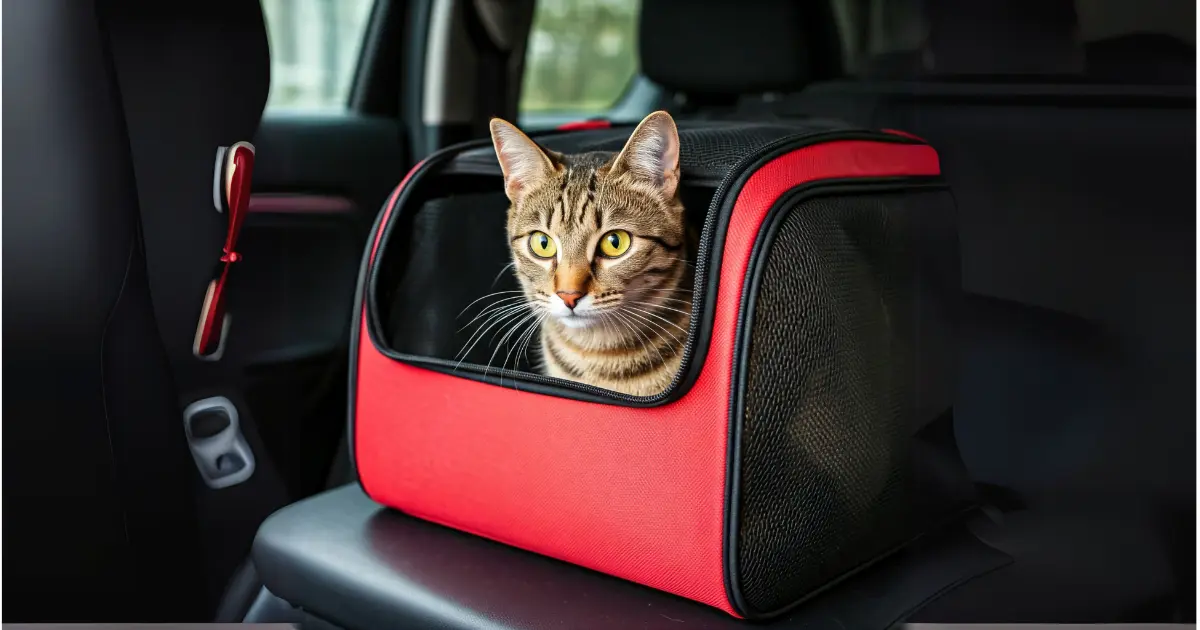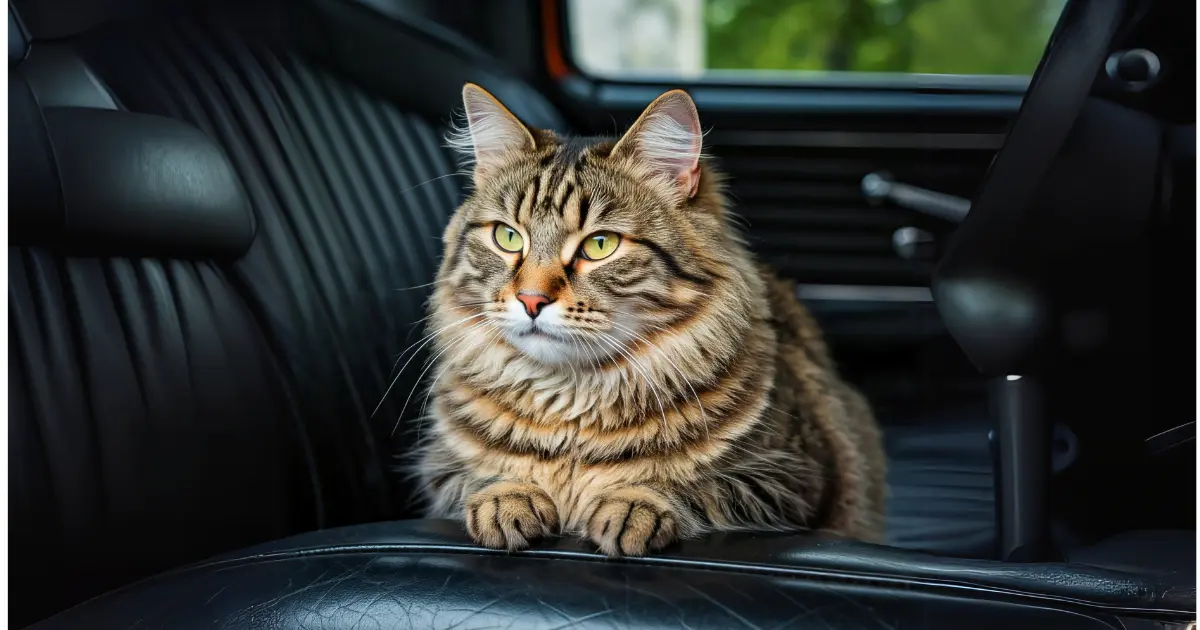Traveling with a Cat in the Car: Tips for a Stress-Free Journey
Published: 4 Jan 2025
Taking your cat on a car trip may seem daunting, but with some preparation, traveling with a cat in the car can become an enjoyable experience for both of you. Whether you’re going on a short drive or a long road trip, keeping your furry friend safe and comfortable is essential.
Table of Contents
Why Traveling with a Cat Can Be Challenging
Unlike dogs, cats aren’t naturally fond of car rides. They tend to prefer staying in familiar surroundings and may experience anxiety or discomfort in unfamiliar environments. That’s why it’s essential to understand how to travel by car with a cat and make the journey as stress-free as possible.

How to Prepare for Traveling with Your Cat
Follow these tips to ensure your cat has a smooth and safe trip:
1. Invest in a Suitable Carrier
A secure carrier is essential for keeping your cat safe while travelling. Ensure the carrier is spacious enough for your cat to move around but not too large. A well-ventilated carrier with a secure door or opening will keep your pet calm and prevent accidents.
Tip: Place your cat’s favourite blanket or toy inside to make them feel at ease.
2. Get Your Cat Used to the Carrier
If your cat isn’t accustomed to its carrier, introduce it to it well before your trip. Leave it open in a quiet spot in the house so your cat can explore it independently. Let them sleep inside for a few days leading up to the journey.

3. Take Short Test Drives
If you’re wondering how to help cats with long car rides, one of the best ways to prepare is to take shorter trips first. This will help your cat adjust to the car’s motion before embarking on longer journeys. Start with 10-15-minute drives and gradually increase the duration to see how your cat reacts.
4. Plan Breaks for Longer Trips
Planning for frequent stops is essential if you’re wondering how to bring cats on long car rides. Cats, like humans, need time to stretch their legs and relax. Stop every 2-3 hours to let your cat drink water, use the litter box, or rest.
“Long journeys can be particularly challenging for pets with thick fur. If you’re traveling with a long-haired cat, regular brushing and care are essential to keep them comfortable.”
Necessary: Never open the carrier while driving. Always pull over to a safe area first.
5. Keep the Car Comfortable
If you’re wondering how long cats can ride in a car, it depends on the cat, but making the environment as comfortable as possible will help. Depending on the weather, Keep the car cool or warm. Avoid placing the carrier in direct sunlight, and ensure proper ventilation to keep your cat at ease.
6. Don’t Feed Right Before the Trip
Avoid giving your cat a large meal just before travelling to reduce the risk of motion sickness. Instead, offer a light meal 4-6 hours before departure.
Tip: If your cat is prone to car sickness, consider discussing medication to calm cats for travel with your vet.
7. Maintain a Calm Atmosphere
Sudden noises, sharp turns, or fast driving can make your cat nervous. To minimize stress, keep the car ride as smooth as possible.
- Avoid loud music or sudden speed changes.
- Consider using calming music or white noise to help soothe your cat.
8. Bring the Essentials
You should never forget a few key items when travelling with a cat. These will make the trip easier for both you and your pet:
- Water and food bowls
- Litter box (for long trips)
- Favourite toys or blankets
- Waste bags
- These items will ensure your cat feels more at home and reduce anxiety. What things are needed when you travel with a cat? Make sure you have the basics to keep your feline friend comfortable.
- “Don’t forget to pack your cat’s favorite food and maintain proper hydration. For tips on healthy eating, check out our guide on cat nutrition.”
9. Consider Calming Solutions
If your cat has severe anxiety, you may need some extra help. There are various calming aids you can try:
- Feliway spray: This synthetic pheromone helps reduce stress and anxiety in cats.
- Calming collars release soothing scents that can help calm your cat.
- Prescription or over-the-counter medication: Talk to your vet to see if medication might be appropriate for your cat’s anxiety.
How to Help Cats with Car Anxiety
Taking the proper precautions is essential for cats that experience anxiety in the car. Providing a calming environment, using pheromone sprays, and gradually getting your cat used to the vehicle can reduce stress. Some cats also benefit from anti-anxiety medications prescribed by a vet.
Can Cats Take Long Car Rides?
The answer depends on the cat’s temperament, health, and comfort level in the car. Most cats can travel for a few hours without issues, but longer trips may require more breaks and special attention. How to help cats with long car rides involves ensuring they are well-rested, hydrated, and comfortable. Taking regular breaks and keeping your cat’s favourite things close by can make the journey much more manageable.
“If you’re traveling in colder months, it’s essential to ensure your cat stays warm and cozy. Learn more about how to keep cats warm in winter.”

Traveling the World with a Cat
If you plan to travel the world with a cat, you must begin with short trips and gradually build up to longer journeys. Travelling internationally with a cat involves extra preparation, such as learning about pet passports, vaccination requirements, and quarantine regulations. Starting with domestic travel will allow both you and your cat to adjust to the process, making future adventures smoother and less stressful.
“Using a tracking device like an AirTag for Cats can help ensure you always know where your feline friend is, whether on a road trip or flying internationally.”
Transporting Kittens in the Car
Travelling with kittens requires extra care. Because they are more sensitive, making the trip as smooth and calm as possible is essential. Use a soft-sided carrier, keep them hydrated, and allow extra time for breaks. Kittens are especially vulnerable to stress, so try to make their first car trip a positive experience.
“If you’re traveling with a Sphynx kitten, proper grooming before the trip is essential. Learn more in our detailed guide on Sphynx Kitten Bathing Routine.”
Final Thoughts: Travel Together, Stress-Free
Travelling with a cat doesn’t have to be a stressful experience. Whether you’re asking how to car travel with a cat or trying to figure out how long cats can ride in a vehicle, the key is preparation. Using the right carrier, planning your breaks, and keeping your cat comfortable can make the journey enjoyable for both of you. A little effort goes a long way, whether on a short trip or a more extended road adventure.
Have you travelled in the car with your cat? Share your tips or experiences in the comments below!
“By following these tips, you can ensure a smooth trip with your cat. For more expert advice on pet travel, check out the American Kennel Club’s tips for traveling with pets.”
FAQ
If your cat is calm, quiet, or even naps during the ride, it’s a good sign they’re comfortable. Look out for signs of stress, like excessive meowing, panting, or trying to escape the carrier. Ensuring they have familiar items in their carrier and keeping the environment calm can help.
If your cat gets car sick, avoid feeding them a large meal before the trip, and keep the car well-ventilated. Talk to your vet about anti-nausea medications or natural remedies that can help. Short, practice trips can also help them build tolerance to car rides.
It’s best to keep your cat in a secure carrier for their safety and yours. A loose cat can be a distraction and could get injured in the event of a sudden stop or accident. Always pull over to a safe area if you need to check on your cat or let them stretch.
Yes, cats can handle long car trips with proper preparation. Plan for regular stops every 2-3 hours to let them drink water, use the litter box, and relax. Make sure they’re comfortable in their carrier and bring familiar items to reduce stress.
Introduce your cat to the carrier in a positive way, letting them explore it at home first. Take short practice trips to get them used to the car’s motion and sounds. Use calming aids, like pheromone sprays or favorite toys, to make the experience less stressful.

- Be Respectful
- Stay Relevant
- Stay Positive
- True Feedback
- Encourage Discussion
- Avoid Spamming
- No Fake News
- Don't Copy-Paste
- No Personal Attacks



- Be Respectful
- Stay Relevant
- Stay Positive
- True Feedback
- Encourage Discussion
- Avoid Spamming
- No Fake News
- Don't Copy-Paste
- No Personal Attacks





